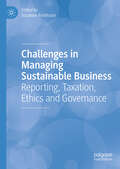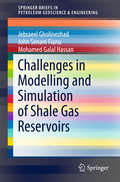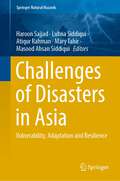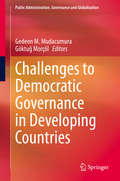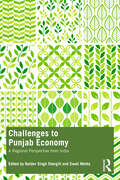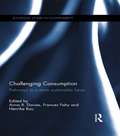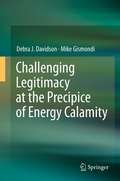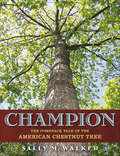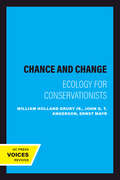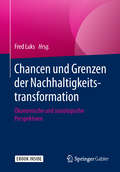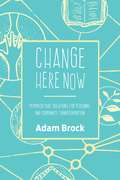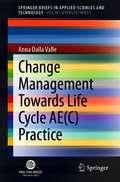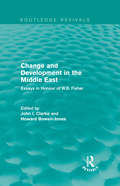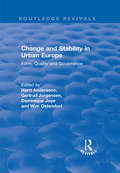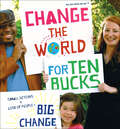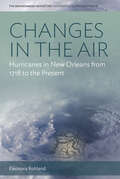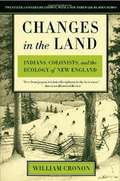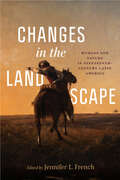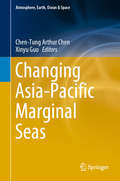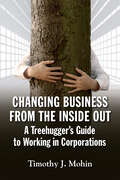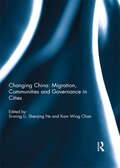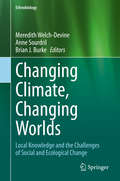- Table View
- List View
Challenges in Managing Sustainable Business: Reporting, Taxation, Ethics and Governance
by Susanne ArvidssonOver the past 30 years sustainability has become increasingly important to scholarly research and business in practice. This book explores a variety of challenges faced by businesses when becoming sustainable and how this links to economic development and its corruption, ethical and taxation implications. Showcasing an interdisciplinary approach, the chapters explore topics such as business ethics, corporate responsibility, tax governance and sustainability practice.
Challenges in Modelling and Simulation of Shale Gas Reservoirs (Springerbriefs In Petroleum Geoscience And Engineering Ser.)
by Jebraeel Gholinezhad John Senam Fianu Mohamed Galal HassanThis book addresses the problems involved in the modelling and simulation of shale gas reservoirs, and details recent advances in the field. It discusses various modelling and simulation challenges, such as the complexity of fracture networks, adsorption phenomena, non-Darcy flow, and natural fracture networks, presenting the latest findings in these areas. It also discusses the difficulties of developing shale gas models, and compares analytical modelling and numerical simulations of shale gas reservoirs with those of conventional reservoirs. Offering a comprehensive review of the state-of-the-art in developing shale gas models and simulators in the upstream oil industry, it allows readers to gain a better understanding of these reservoirs and encourages more systematic research on efficient exploitation of shale gas plays. It is a valuable resource for researchers interested in the modelling of unconventional reservoirs and graduate students studying reservoir engineering. It is also of interest to practising reservoir and production engineers.
Challenges of Disasters in Asia: Vulnerability, Adaptation and Resilience (Springer Natural Hazards)
by Haroon Sajjad Atiqur Rahman Lubna Siddiqui Mary Tahir Masood Ahsan SiddiquiThe book provides an understanding about the disaster impacts, vulnerability assessment, adaptation pathways and mitigation for strengthening the resilience of the society to various hazards. Multi- dimensionality of disasters is depicted by various approaches and effective modelling. The book is a synthesis of research papers presented at online International Conference on the theme organized by the Centre for Disaster management, Department of Geography, Jamia Millia Islamia in collaboration with National Institute of Disaster Management and Regional Remote Sensing Centre (North), Indian Space Research Organization (ISRO), New Delhi, India during 02-03 March, 2021. The book has been organized into four parts spreading over 28 chapters. Part I deals with the impact assessment of various disasters. Part II examined ecological and socio-economic vulnerability arising out of the disasters. Part III identifies possible solutions for lessening vulnerability to disasters and effective adaptation strategies. Finally, part IV provides an insight for making the societies resilient to the disasters. The main focus of each chapter was laid implicitly on policy concerns focusing on disaster reduction at spatial scales. The book will immensely be helpful for the researchers, academicians and scientific communities for discussing set of questions necessary for future research. It will attract the attention of functionaries, practitioners, policy makers, training institutes and stakeholders for making appropriate methods of communicating risks and adaptation strategies for disaster management.
Challenges to Democratic Governance in Developing Countries (Public Administration, Governance and Globalization #11)
by Gedeon Mudacumura Göktuğ MorçölDespite the large amounts of human and financial resources invested to foster democratic governance in developing countries, statistics show that the majority of these countries have not yet achieved significant improvements in living standards. While some regions make strides towards improving the living conditions of their citizens, Sub-Saharan Africa, for instance, is still trapped in poverty with more than 40% of its 600 million people living below the internationally recognized absolute poverty line of one US dollar per day. Poor governance and corruption should be highlighted as the most important systemic factors contributing to poverty in developing countries. As a result the institutional foundations of these countries are weakened, public funds are misappropriated, and policies and programs aimed at reducing poverty and fostering sustainable economic growth are undermined. It is therefore not surprising that a 2008 Transparency International report found a direct link between corruption and the failure of the societal institutions designed to achieve the Millennium Development Goals in the majority of developing countries. This book investigates the problems of democratic governance, particularly as they relate to corruption, and also whether democracy should be based on universal principles or local context and historical factors. It also analyses the rule of law, in promoting democratic governance and curbing corruption and if governmental, non-governmental organizations, and civil societies are effective in promoting democratic governance and curbing corruption. This book will go beyond identifying the challenges and offer plausible solutions that could be adapted to various developing countries. It is premised on the importance of bridging theory and practice, which has been lacking in most local and international development publications, making of interest to scholars and policy-makers alike concerned with public administration in developing countries.
Challenges to Punjab Economy: A Regional Perspective from India
by Baldev Singh Shergill and Swati MehtaThis volume looks at the challenges faced by the economy and society in Punjab, India. It probes into the economic issues, institutional development and resources imbalance faced by the Punjab economy. It discusses regional research problems and futuristic approaches for a developing economy. The chapters in this volume: focus on comprehending economic challenges, agrarian structure and development; markets, R&D and public policy; manufacturing sector; opportunities and possibilities; examine labour, caste and gender trajectories, exploring the question of freedom and livelihood; human, social and financial resources development; hunger, diet and disease; challenges for development paradigm; present the macro and micro facets of development processes in the region and offer a way forward for long-run growth, sustainability and inclusiveness amidst the dynamic fast-changing economies across the globe. Comprehensive and analytical in its approach, this volume will be of interest to young researchers, scholars, practitioners and policymakers working in the fields of Development Economics, Regional Economics, Evolutionary Economics, Sustainable Economics, Agrarian Development, Manufacturing and Labour.
Challenging Consumption: Pathways to a more Sustainable Future (Routledge Studies in Sustainability)
by Frances Fahy Henrike Rau Anna R. DaviesSustainable consumption is a central research topic in academic discourses of sustainable development and global environmental change. Informed by a number of disciplinary perspectives, this book is structured around four key themes in sustainable consumption research: Living, Moving, Dwelling and Futures. The collection successfully balances theoretical insights with grounded case studies, on mobility, heating, washing and eating practices, and concludes by exploring future sustainable consumption research pathways and policy recommendations. Theoretical frameworks are advanced throughout the volume, especially in relation to social practice theory, theories of behavioural change and innovative visioning and backcasting methodologies. This groundbreaking book draws on some conceptual approaches which move beyond the responsibility of the individual consumer to take into account wider social, economic and political structures and processes in order to highlight both possibilities for and challenges to sustainable consumption. This approach enables students and policy-makers alike to easily recognise the applicability of social science theories.
Challenging Legitimacy at the Precipice of Energy Calamity
by Mike Gismondi Debra J. DavidsonHuman history has often been described as a progressive relinquishment from environmental constraints. Now, it seems, we have come full circle. The ecological irrationalities associated with industrial societies have a lengthy history, and our purpose in the proposed book is not to catalogue this litany of wrongs. Rather, this book is about political responses to global environmental crisis at a crucial turning point in history, by focusing on the political discourses surrounding the tar sands in Alberta, Canada.
Champion: The Comeback Tale of the American Chestnut Tree
by Sally M. WalkerAmerican chestnut trees were once found far and wide in North America's eastern forests. They towered up to one hundred feet tall, providing food and shelter for people and animals alike. For many, life without the chestnut seemed unimaginable—until disaster struck in the early 1900s.What began as a wound in the bark of a few trees soon turned to an unstoppable killing force. An unknown blight was wiping out the American chestnut, and scientists felt powerless to prevent it. But the story doesn't end there. Today, the American chestnut is making a comeback. Narrative nonfiction master Sally M. Walker tells a tale of loss, restoration, and the triumph of human ingenuity in this beautifully photographed middle-grade book.
Chance and Change: Ecology for Conservationists
by William Holland Drury Jr.The result of a lifetime in the field and in the classroom, Chance and Change challenges many of the tenets of establishment ecology. Charging that most of the environmental movement has ignored or rejected the changes in thinking that have infiltrated ecological theory since the mid 70s, William Drury presents a convincing case that disorder is what makes the natural world work, and that clinging to romantic notions of nature's grand design only saps the strength of the conservation movement. Drury's training in botany, geology, and zoology as well as his life-long devotion to work in the field gave him a depth and range of knowledge that few ecologists possess. This book opens our eyes to a new way of looking at the environment and forces us to think more deeply about nature and our role in it.Chance and Change is intended for the serious amateur naturalist or professional conservationist. Drury argues that chance and change are the rule, that the future is as unpredictable to other organisms as it is to us, and that natural disturbance is too frequent for equilibrium models to be useful. He stresses the centrality of natural selection in explaining the meaning of biology and insists the book and the laboratory must be checked at all times against the real world. Written in an easy, personal style, Drury's narrative comes alive with the landscape—the salt marshes, dunes, seashores, and forests—that he believed served as the best classroom. His novel approach of correlating landscape evolution with ecological principles offers a welcome corrective to discordance between what we observe in nature and what theory tells us we should see.
Chance statt Show – Bürgerbeteiligung mit Virtual Reality & Co.: Akzeptanz und Wirkung der Visualisierung von Bauvorhaben (Politik gestalten - Kommunikation, Deliberation und Partizipation bei politisch relevanten Projekten)
by Arne SpiekerMit klassischen Planunterlagen oder Bildmontagen können Normalbürger*innen Nutzen und Auswirkungen von Bauvorhaben kaum einschätzen. Heute ermöglichen anmutungstreue und räumlich frei erlebbare 3D-Modelle spektakuläre Anwendungen, bei denen der Betrachter so vollkommen in die Planungen eintaucht als wären sie bereits realisiert. Arne Spieker formuliert Anforderungen an den Einsatz in der Bürgerbeteiligung zu Bauvorhaben und untersucht die Akzeptanz sowie Wirkung unterschiedlicher Visualisierungstechnologien bei Bürger*innen. Er zeigt, dass Echtzeitsimulationen und Virtual Reality gruppenübergreifend großes Potenzial besitzen, wenn statt schicker Bilderwelten Glaubwürdigkeit und Informationsgehalt im Vordergrund stehen.
Chancen und Grenzen der Nachhaltigkeitstransformation: Ökonomische und soziologische Perspektiven
by Fred LuksVerschaffen Sie sich einen Überblick über die aktuelle Diskussion zum Thema Nachhaltigkeitstransformation – mit diesem Buch In Zeiten von Klimaerwärmung und Meeresverschmutzung durch Plastikmüll versuchen mehr und mehr Menschen, nachhaltig zu leben. Inzwischen gehen immer öfter auch Betriebe dazu über, eine grüne Unternehmenspolitik zu betreiben. Doch noch ist es ein langer Weg, bis der Wandel hin zu einer umweltfreundlichen sowie ressourcen- und energieschonenden Gesellschaft geschafft ist. Passend dazu gibt dieses Buch über die Nachhaltigkeitstransformation einen Einblick in die aktuelle wissenschaftliche Diskussion zu diesem Thema. Darin finden Sie Beiträge aus verschiedenen Disziplinen, zum Beispiel: VolkswirtschaftslehreBetriebswirtschaftslehreSoziologieRechtswissenschaftTechnik Das Buch richtet sich nicht nur an Akademiker, Lehrende und Studenten, sondern an alle Personen, die sich für die Themen ökologische und soziale Nachhaltigkeit, Corporate Social Responsibility sowie Umwelt- und Klimaschutz interessieren. Wie kann die Transformation zu einer nachhaltigen Entwicklung gelingen? Diese und andere Fragen versucht dieses Buch zur Nachhaltigkeitstransformation zu beantworten. Es zeigt Notwendigkeiten, Hindernisse und Grundsatzprobleme auf und zeigt die Meinungen anerkannter Experten dieses Fachbereichs. Diese beschäftigen sich mit allen gängigen Problembereichen des Nachhaltigkeitsmanagements: TechnologieNachhaltigkeit in der WirtschaftKonsumHindernisse der TransformationGrünes WachstumInnovationNachhaltigkeitsstrategienRolle der Wissenschaft Dabei sollen aber nicht alle Forschungsfelder für sich stehen. Vielmehr versuchen die Autoren zu zeigen, wie das Zusammenspiel aus allen Faktoren das künftige Leben der Menschen verändern könnte.
Change Here Now: Permaculture Solutions for Personal and Community Transformation
by Adam BrockAward-winning social entrepreneur and permaculturalist Adam Brock draws from ecology, sociology, community economics, social justice, and indigenous practices the world over to present more than eighty proven solutions for building healthy communities. Using the "pattern language" framework developed by architect Christopher Alexander and his colleagues in the 1970s, Brock outlines strategies for redesigning our social and economic systems to mimic nature's resilience and abundance. Practical, innovative, and visually compelling, this book presents actionable and easy-to-understand tools for a compassionate and methodical approach to building better communities. Sidebars and diagrams supplement the text, while case studies illustrate endeavors such as starting a business, launching a social change project, or setting personal goals. Brock suggests ways to engage disempowered communities in a meaningful and authentic way, and draws on eight years of in-depth research and investigation to demonstrate what makes communities work at the most fundamental level. Anyone looking for concrete solutions to many of the social and economic ills that plague our current society will discover a rich resource for growth and change.
Change Management Towards Life Cycle AE (SpringerBriefs in Applied Sciences and Technology)
by Anna Dalla ValleThe book explores how architectural, engineering and construction (AEC) firms have been adapting and changing to effectively address key environmental challenges, focusing on Life Cycle Thinking and related methodologies (Life Cycle Assessments and Life Cycle Costing). Starting from current practice, the book outlines the necessary change management to turn into life cycle AE(C) practice, switching from a product-technology mindset to a life cycle thinking and holistic approach. Although the primary audience of the book are Architectural and Engineering firms, the broad range of topics encourages readers from different backgrounds to explore the latest advancements in construction sector. Service companies and software developers can find inspiration to develop innovative tools and solutions, clients can find ways to demand sustainability as key target for building design and universities can align academic programmes to address new industry challenges.
Change and Development in the Middle East: Essays in honour of W.B. Fisher (Routledge Revivals)
by John I. Clarke and Howard Bowen-JonesThe Middle East is a region of great traditional diversity, which has been characterized by immense political, social and economic changes, still developing over thirty years after the title’s original publication. A group of oil-rich countries have achieved great political significance and some of the highest per capita incomes in the world. Much modern development has been spatially polarized, accentuating the concentrations of rapidly growing populations and posing severe problems for planners. Cultivation and pastoralism, the main traditional activities, have often suffered from neglect and insufficient investment, and both require re-evaluation. These are the issues addressed by this volume, first published in 1981, which contains a series of overviews and case studies written by present or former members of staff and research students of the Department of Geography in the University of Durham in honour of W.B. Fisher. Change and Development in the Middle East provides an interesting and relevant geographical and demographic analysis of this diverse and volatile region.
Change and Stability in Urban Europe: Form, Quality and Governance (Routledge Revivals)
by Gertrud Jorgensen Wim OstendorfThis title was first published in 2001. Significant transformations in the spatial organization of European cities have taken place over the past two decades. Social fragmentation, increasingly complex systems of governance, the transformation of relations to public space and the shift of work from the industrial to the communications sectors, have placed increasing importance on a city’s position in terms of the global network. This book brings together an interdisciplinary team of European experts to discuss how these transformations have forced a radical reconsideration of the traditional definitions of the city. Comparing a wide range of European cities, the book highlights the diversity of urban forms and tackles the questions regarding the quality of life in new urban spaces. The result is a comprehensive and incisive examination of the capacity of urban policies to evoke real changes in the city and to regenerate the systems of urban governance.
Change the World for Ten Bucks: Small Actions X Lots Of People = Big Change
by We Are What We DoFifty simple actions we can all do to make the world a better place—from talking to the young and elderly to ending the use of plastic bags. In 2004, a London-based community organization called We Are What We Do launched with the publication of a little book with a big idea: fifty simple actions to make the world a better place. Since then, Change the World for Ten Bucks has spawned a movement, multiple editions, and sales of over one million copies internationally. At last, here&’s the US edition. Change the World for Ten Bucks delights and engages at every turn. It also includes dozens of creative prompts for positive change
Changes in Paddy Soil Fertility in Tropical Asia under Green Revolution: From the 1960s to the 2010s
by Junta Yanai Sota Tanaka Shin Abe Atsushi NakaoThis book investigates the effect of the Green Revolution (GR) on long-term changes in the fertility status of paddy soils in tropical Asia. While information on long-term changes in soil fertility status are rather limited due to difficulties in obtaining past data or samples for comparison, this investigation on temporal changes in soil fertility is possible by comparing fertility status in the 2010s, which the authors examined recently, with those from the 1960s, when GR was initiated, which was reported by Kawaguchi & Kyuma (1977). More than 220 paddy soils collected from Thailand, the Philippines, Malaysia, Bangladesh, and Indonesia were analyzed for their physicochemical properties as well as total and available fractions of plant macro- and micro- essential elements, and their temporal changes were examined in addition to their spatial variation in each country. The most significant change was a drastic increase of available phosphorus in soils, possibly due to fertilization after the GR. Changes in organic matter, pH, and other nutrients were relatively small. A considerable decrease in the content of some micronutrients was also observed. Long-term studies on soil fertility status in the past and present will be useful to establish soil/fertilizer management for sustainable rice production in the future. This book is an essential reading for soil scientists, agricultural scientists, environmental scientists, as well as policymakers and nongovernmental officers such as FAO.
Changes in the Air: Hurricanes in New Orleans from 1718 to the Present (Environment in History: International Perspectives #15)
by Eleonora RohlandHurricanes have been a constant in the history of New Orleans. Since before its settlement as a French colony in the eighteenth century, the land entwined between Lake Pontchartrain and the Mississippi River has been lashed by powerful Gulf storms. Time and again, these hurricanes have wrought immeasurable loss and devastation, spurring reinvention and ingenuity on the part of inhabitants. Changes in the Air offers a rich and thoroughly researched history of how hurricanes have shaped and reshaped New Orleans from the colonial era to the present day, focusing on how its residents have adapted to a uniquely unpredictable and destructive environment across more than three centuries.
Changes in the Land: Indians, Colonists, and the Ecology of New England
by John Demos William CrononThe book that launched environmental history now updated. Winner of the Francis Parkman Prize In this landmark work of environmental history, William Cronon offers an original and profound explanation of the effects European colonists' sense of property and their pursuit of capitalism had upon the ecosystems of New England. Reissued here with an updated afterword by the author and a new preface by the distinguished colonialist John Demos,Changes in the Land, provides a brilliant inter-disciplinary interpretation of how land and people influence one another. With its chilling closing line, "The people of plenty were a people of waste," Cronon's enduring and thought-provoking book is ethno-ecological history at its best.
Changes in the Landscape: Humans and Nature in Nineteenth-Century Latin America
by Stephanie NiuChanges in the Landscape is a collection of timely essays that bring the methodologies and commitments of ecocriticism to bear on the study of Latin American literature and cultural production. The book&’s eleven chapters, written by some of the leading voices in the field, invite readers to consider how the relationship between humans and nonhuman nature was fundamentally transformed during a period when new modes of capitalist production were emerging in the region and around the world. Jennifer L. French&’s introductory essay provides a historical and theoretical framework for the collection. Ranging from the immediate aftermath of the Spanish‑American Wars of Independence (1810–1826) to the early twentieth century (1925), the volume&’s essays cover a wide variety of genres and forms of cultural production, from José Hernández&’s epic poem Martín Fierro to prose fiction, painting and photography, and the personal albums compiled by Spanish-American women. Individually and collectively, the essays engage with scientific writing as both a discourse of power and a source of potentially significant, even revelatory information about human and nonhuman nature. Changes in the Landscape enables readers to more fully understand the transition from colonial regimes to the ecocidal extractivism of the export boom (1870–1930) by drawing out and analyzing some of the cognitive resources and rhetorical strategies that were available to imagine, protest, or enact new norms and expectations regarding the relations between human and nonhuman life, be it the life of wildflowers, waterfalls, or Cuba&’s Ciénaga de Zapata.
Changing Asia-Pacific Marginal Seas (Atmosphere, Earth, Ocean & Space)
by Chen-Tung Arthur Chen Xinyu GuoThis book discusses temporal changes in six Asia-Pacific marginal seas and two west boundary currents in the Northwest Pacific. Covering time scales varying from years to decades, it provides a comprehensive review of the long-term changes in various physical variables, including sea level, sea surface temperature, water mass index, current and transport, as well as local issues such as sea ice and tidal mixing, and the processes and dynamics that govern them. The book also examines biogeochemical variables, such as nutrients, oxygen, pH, water transparency, ocean acidification, eutrophication and productivity, and explores future trends. Offering a holistic view of the changes that have occurred in the Asia-Pacific marginal seas and those that are likely to occur in the future, this book will appeal to readers from all fields of oceanography.
Changing Business from the Inside Out: A Tree-Hugger's Guide to Working in Corporations
by Tim MohinThe BP oil spill, the 2008 global financial collapse, and revelations of scandalous working conditions at Chinese electronics supplier Foxconn show why so many are suspicious of promises of corporate responsibility. But slowly and fitfully, corporations are changing. It’s not just because of the high cost of making amends and a fear of negative publicity. Consumers are demanding better corporate behavior, and an increasing number of executives are eager to make their organizations more of a force for good. But corporations can’t act in responsible ways if no “treehuggers” are working inside the system to lead the effort. For more than two decades, Timothy J. Mohin has worked to improve working conditions, clean up factories, and battle climate change—all while being employed by some of the biggest companies in the world. In Changing Business from the Inside Out he’s written the first practical, authoritative insider’s guide to creating a career in corporate responsibility. Mohin describes how to get started and what the day-to-day experience of being “the designated driver at the corporate cocktail party” is really like. He recounts colorful case studies from his own career, provides advice on how CSR workers can have greater impact, and even looks into how employees in other corporate functions can make a difference. He details the programs and processes needed to support a comprehensive CSR effort, but perhaps most importantly, he identifies the personal and professional skills needed to navigate corporate politics and get buy-in from sometimes skeptical colleagues. With more than 80 percent of the Fortune 500 now publishing “sustainability reports,” a new career path has been forged in corporate responsibility. From strategy to data mining to supply chains and communication, this book is the “operator’s manual” for this new career path.
Changing China: Migration, Communities and Governance in Cities
by Si-ming Li, Shenjing He and Kam Wing ChanChina’s unprecedented urbanization is underpinned by not only massive rural-urban migration but also a household registration system embedded in a territorial hierarchy that produces lingering urban-rural duality. The mid-1990s onwards witnessed increasing reliance on land revenues by municipal governments, causing repeated redrawing of city boundaries to incorporate surrounding countryside. The identification of real estate as a growth anchor further fueled urban expansion. Sprawling commodity housing estates proliferate on urban-rural fringes, juxtaposed with historical villages undergoing intense densification. The traditional urban core and work-unit compounds also undergo wholesale redevelopment. Alongside large influx of migrants, major reshuffling of population has taken place inside metropolitan areas. Chinese cities today are more differentiated than ever, with new communities superimposing and superseding older ones. The rise of the urban middle class, in particular, has facilitated the formation of homeowners’ associations, and poses major challenges to hitherto state dominated local governance.The present volume tries to more deeply unravel and delineate the intertwining forms and processes outlined above from a variety of angles: circulatory, mobility and precariousness; urbanization, diversity and segregation; and community and local governance. Contributors include scholars of Chinese cities from mainland China, Hong Kong, Canada, Australia and the United States. This volume was previously published as a special issue of Eurasian Geography and Economics.
Changing Climate, Changing Worlds: Local Knowledge and the Challenges of Social and Ecological Change (Ethnobiology)
by Meredith Welch-Devine Anne Sourdril Brian J. BurkeThis book explores how individuals and communities perceive and understand climate change using their observations of change in the world around them. Because processes of climatic change operate at spatial and temporal scales that differ from those of everyday practice, the phenomenon can be difficult to understand. However, flora and fauna, which are important natural and cultural resources for human communities, do respond to the pressures of environmental change. Humans, in turn, observe and adapt to those responses, even when they may not understand their causes. Much of the discussion about human experiences of our changing climate centers on disasters and extreme events, but we argue that a focus on the everyday, on the microexperiences of change, has the advantage of revealing how people see, feel, and make sense of climate change in their own lives. The chapters of this book are drawn from Asia, Europe, Africa, and South and North America. They use ethnographic inquiry to understand local knowledge and perceptions of climate change and the social and ecological changes inextricably intertwined with it. Together, they illustrate the complex process of coming to know climate change, show some of the many ways that climate change and our responses to it inflict violence, and point to promising avenues for moving toward just and authentic collaborative responses.
Changing Climates, Earth Systems and Society (International Year of Planet Earth)
by John DodsonThe book covers state-of-the-art considerations on how climate change has and will deliver impacts on major globalised biophysical and societal themes that will affect the way the world functions. Human activity has resulted in changes to atmospheric chemistry and land cover, and caused serious decline in biodiversity. Modifying biogeochemical cycles leads to complex feedbacks. The future climate will have impact on food security and agriculture, water supply and quality, storm and cyclone frequency, shoreline stability, biodiversity and the future of biological resources. Earth scientists might be asked to forecast any potential abrupt or environmental surprises. A sound knowledge of the Earth System will improve the chances of achieving this, by developing climate models that will reduce the degree of uncertainty in regional climate prediction. . This volume sets out a framework of research issues that show how the Earth sciences contribute to a better understanding of climate change and suggests where future research will best contribute to the wellbeing of society. The key topics discussed are: - climate change patterns over the last four glacial cycles; - the variability in climate over the last 1000 years; - impact that past climate change has had on societies; - the role of human activities in climate forcing; - the role of models in predicting future climate and how we can assess their merit; - the future and likely future climate trajectories.
